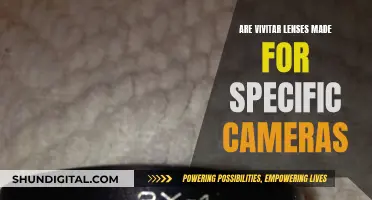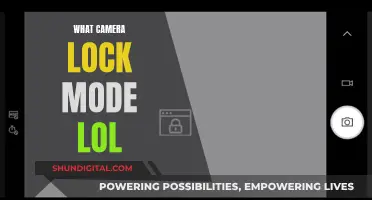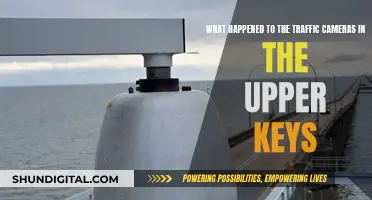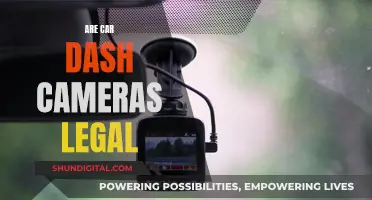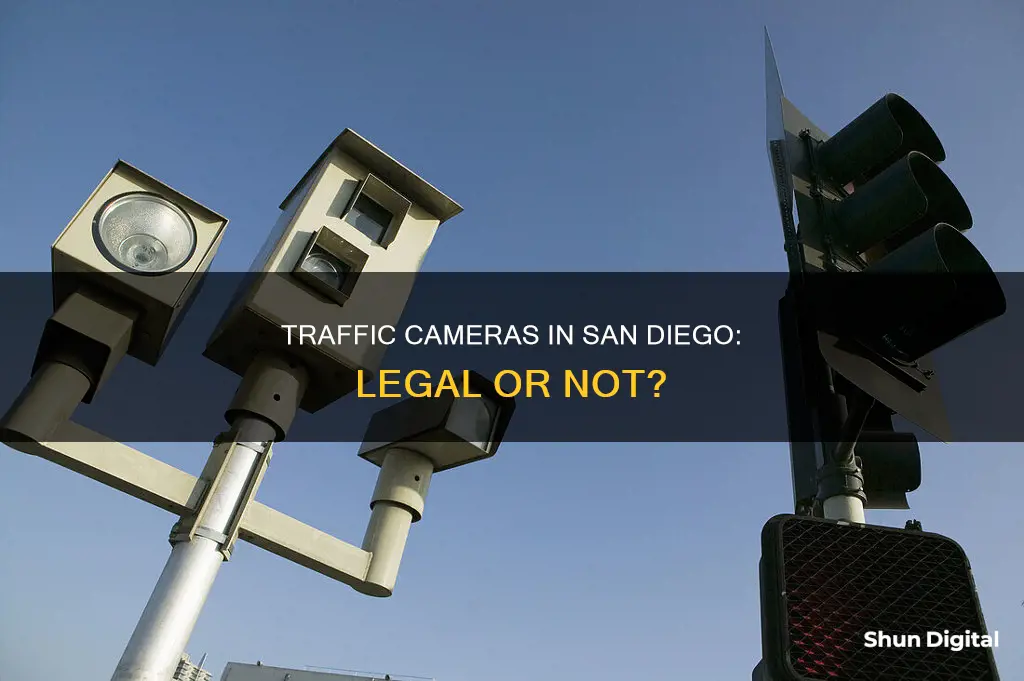
Traffic cameras are not illegal in San Diego County. In fact, the San Diego Police Department has been installing and using Smart Streetlight cameras and Automated License Plate Recognition (ALPR) technologies. While these cameras are legal, there are limits to their use. For example, the cameras and ALPR can only operate in conjunction with an LED streetlight, and video captured by the streetlight cameras is deleted after 13 days. Additionally, there are restrictions on red-light cameras in California, such as the requirement for a clear picture of both the vehicle and the driver for a fine to be issued.
What You'll Learn

Privacy concerns
Traffic cameras in San Diego have raised several privacy concerns among residents and privacy advocates. In 2016, the city installed 3,200 "Smart Streetlights" equipped with cameras to monitor traffic and pedestrian movements for planning and transportation purposes. However, residents became concerned about data and video sharing with third parties, privacy issues, and a lack of notification about how the data would be used.
The Smart Streetlights program faced further criticism when it was revealed that law enforcement used the cameras for criminal investigations without the public's knowledge. This led to concerns about mass surveillance, with community members in urban areas stating that the cameras violated their privacy, targeted minorities, and contributed to a growing distrust of the police. As a result, the city discontinued the program in 2018 due to privacy concerns and cost overruns.
In 2023, the San Diego Police Department proposed reinstating cameras and license plate readers on streetlights in 500 locations deemed high-crime areas. This proposal faced opposition from community members and privacy advocates who felt they were being unfairly targeted, spied on, and tracked without their consent. The Privacy Advisory Board, a committee formed to review surveillance proposals, also rejected the proposal due to a lack of transparency in data collection and insufficient safeguards.
Despite these concerns, the city moved forward with the reinstatement of the smart streetlight program, with the cameras and license plate readers in place by February 2024. The city implemented safeguards, such as privacy masking to protect areas where individuals should expect privacy, and committed to deleting footage and license plate data within a specified timeframe. However, privacy groups continued to express concerns about the level of surveillance and the potential for privacy invasions.
Computer Camera: Capturing Data as an Input Device
You may want to see also

Cost overruns
In 2016, the city of San Diego installed 3,200 cameras on streetlights, which were meant to monitor traffic and pedestrian movements to aid in planning and transportation. However, the program faced criticism due to concerns about privacy, data sharing with third parties, and a lack of transparency around data usage. In 2020, city leaders shut down the network of cameras due to these concerns.
The $30.23 million program also encountered cost overruns, with the city facing $2.3 million in cost overruns due to higher-than-expected energy costs, transmission fees, data analysis, and other unforeseen expenses. The program's initial failure and cost overruns led to the formation of the Privacy Advisory Board, a committee tasked with reviewing surveillance proposals.
In 2023, the San Diego Police Department proposed reinstating the smart streetlight program, this time with a focus on crime-fighting and violence reduction in high-crime areas. The proposal included installing 500 video cameras and 500 Automated License Plate Readers (ALPR) on streetlights. Despite the promise of additional privacy safeguards, the proposal faced opposition from community members, privacy advocates, and the Privacy Advisory Board due to ongoing concerns about privacy, data collection, and transparency.
The smart streetlight program in San Diego has been controversial due to its impact on privacy, data collection, and management. The initial attempt at implementing the program faced cost overruns, with the city exceeding its budget due to various unforeseen expenses. The proposal to reinstate the program has sparked debates about balancing public safety and privacy rights, with community members expressing concerns about mass surveillance and a lack of trust in the police.
Speeding Tickets and Points: What You Need to Know
You may want to see also

Surveillance ordinance
Traffic cameras are not illegal in San Diego County. However, the use of these cameras has sparked concerns about privacy and mass surveillance. In response, the city of San Diego implemented a surveillance ordinance to govern the use of such technologies.
The San Diego Police Department (SDPD) has been installing and utilising Smart Streetlight cameras and Automated License Plate Recognition (ALPR) technologies. The police department claims that these technologies have helped them locate and apprehend dangerous suspects more efficiently.
The surveillance ordinance, known as the Transparent and Responsible Use of Surveillance Technology (TRUST) Ordinance, was passed by the City Council in August 2022. The ordinance established a comprehensive process for reviewing and approving the city's surveillance technology. It required departments to identify existing surveillance tech, hold community meetings, and secure council approval for each item. The TRUST Ordinance was considered one of the most robust surveillance transparency laws in the country.
However, the ordinance has since undergone several amendments, pushed by Mayor Todd Gloria, who argued that it was too broad and restrictive on city operations. Despite opposition from privacy rights advocates, the City Council has made changes to exempt police databases, fixed security cameras, and other technologies from review.
The watchdog group Trust SD Coalition, which helped develop the original ordinance, has expressed concerns about the amendments. They believe that mass surveillance technology can be extremely powerful in tracking people's movements and activities, and that it places too much information in the hands of a select few. They advocate for stronger controls and transparency measures to ensure that the surveillance efforts do not infringe on the privacy and rights of citizens.
In summary, while traffic cameras are not illegal in San Diego County, the use of such surveillance technologies is regulated by the TRUST Ordinance. The ordinance aims to balance the need for public safety with the protection of civil liberties and privacy rights. However, the ongoing amendments to the ordinance have sparked debates between those who prioritise public safety and those who advocate for stronger privacy protections.
Roughing-In Security Cameras: Cable Installation Guide
You may want to see also

Red light cameras
In 2013, San Diego became one of several California cities to remove red-light cameras from its streets. Mayor Bob Filner cited the lack of evidence that the cameras improved safety and suggested that they bred disrespect for the law. He also noted that many residents believed the program was only about generating revenue for the city. The city's transportation department, as well as bicycle and pedestrian groups, expressed concerns about ending the program, arguing that it helped to enforce traffic rules and improve safety. Despite these objections, the city moved forward with the removal of the cameras.
In recent years, there has been a shift back towards the use of surveillance technology in San Diego. In 2023, the San Diego Police Department (SDPD) began installing Smart Streetlight cameras and Automated License Plate Recognition (ALPR) technologies. The mayor, Todd Gloria, stated that these technologies are enhancing the safety of San Diegans while also protecting their right to privacy. The SDPD highlighted the effectiveness of these tools in locating and apprehending dangerous suspects. However, privacy advocates, such as the Trust SD Coalition, have raised concerns about the potential for mass surveillance and the need for stronger controls over the use of this technology.
It is important to note that while red-light cameras may no longer be in use in San Diego, other types of traffic cameras, such as those used to control traffic lights, are still present in the city. Additionally, the legality of red light cameras in California means that motorists can still be fined for running red lights or making illegal right turns.
Fight Iowa Speeding Tickets: Your Camera, Your Defense
You may want to see also

Smart streetlights
In San Diego, smart streetlights with cameras attached have been installed across the city. These streetlights are equipped with various sensors and connected to a central management system, allowing for dynamic lighting and real-time monitoring. While these smart streetlights offer many benefits, such as improved safety and reduced energy costs, some have raised concerns about the level of surveillance they enable.
Benefits of Smart Streetlights
- Improved safety and citizen satisfaction: Smart streetlights enhance security and safety for pedestrians and drivers.
- Energy cost reduction: By adjusting lighting intensity based on factors like human presence and weather conditions, smart streetlights can significantly reduce energy consumption and costs.
- Maintenance savings: The smart lighting system can detect faults and notify maintenance staff, reducing repair costs.
- Reduced carbon emissions and light pollution: The efficient lighting control of smart streetlights helps cut down on light pollution and carbon emissions.
- Extended lamp life: With smart lighting controls, lamps can last longer and respond more quickly to outages.
- Improved traffic management: Real-time data feeds from the streetlights can help track congestion and speed, aiding traffic management.
- Emergency response: The system can automatically detect and respond to emergencies, such as car crashes or crimes.
In San Diego, the Police Department has installed over 100 smart streetlight cameras as of February 2024, with a total of 500 cameras anticipated by June of the same year. These cameras work in conjunction with Automated License Plate Recognition (ALPR) technology. The combination of smart streetlights and ALPR has already assisted the police in various investigations, including homicides, robberies, and stolen vehicle recoveries.
Concerns and Criticisms
While the smart streetlights in San Diego have been praised for enhancing public safety, there are concerns about the level of surveillance they enable. Privacy advocates, such as the Trust SD Coalition, argue that mass surveillance technology can track people's movements and activities, placing sensitive information in the hands of a select few. Additionally, there are worries about the sensitivity of the cameras, which are run by third-party companies, potentially leading to false tickets and fines.
Kami Wire-Free Camera: How Long Does the Battery Last?
You may want to see also
Frequently asked questions
Traffic cameras are not illegal in San Diego County. In fact, the San Diego Police Department has recently begun installing and using Smart Streetlight cameras and Automated License Plate Recognition (ALPR) technologies.
Traffic cameras are used to enforce traffic rules, such as running red lights or speeding. They are also used to help with criminal investigations.
Yes, there are some restrictions on the use of traffic cameras in San Diego County. For example, the San Diego Police Department's Special Projects and Legislative Affairs Unit individually reviews each camera's viewpoint to digitally mask private property so that it is not recorded by the cameras. Video captured by the streetlight cameras is also deleted after 13 days, and ALPR data is deleted after 30 days.
Yes, some people have raised concerns about the level of surveillance and privacy implications of using traffic cameras. Critics argue that this kind of technology tracks where people go and what they do, and places that information in the hands of a select few.



